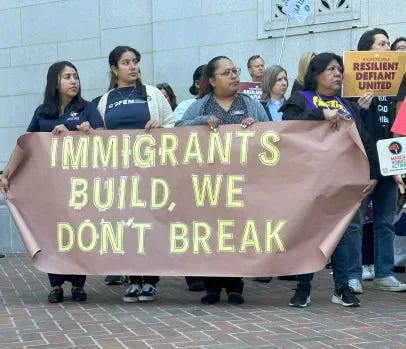IMMIGRATION--YOU DO THE MATH
Eight years ago, Professor Guido Mensio was waiting for his flight to take off from Philadelphia. The University of Pennsylvania Economics professor was working on a differential equation, which drew the attention of a fellow passenger who reported him as a suspected terrorist based on the foreign symbols she observed on his paper pad. Similarly, a 2019 survey found that more than half of Americans believe we should not teach Arabic numerals in schools. Among registered Republicans, 72% were opposed. A nation that fails to recognize and/or is against the digits 0-9 is doomed to misunderstand math, even without the help of hyperbolic statistics about issues such as immigration, and it is no coincidence that much post-election analysis has focused on the “crisis.”
THESE GO TO 11
Indeed, simple math fails to support most news headlines about immigration. For example, to describe the number of migrants who have “poured across” the Southern Border with Mexico, news stories will cite the 8 million encounters border officials recorded since January 2021 and then go on to describe the impact that 8 million unauthorized immigrants have on the economy, public safety, or some other issue. But the number of encounters is not the number of people who stay in the US; many migrants are turned back at the border, and the same person can be and often is recorded trying to enter multiple times.
Beyond that, encounters at the border tell us little about how many unauthorized immigrants enter the country there, as encounters by definition are interactions between border patrol agents and “a removable noncitizen.” Again, large numbers of these people—3.2 million in 2023—are…well…removed. Most of the remaining number apply for asylum status and are processed and allowed to enter the country while awaiting immigration hearings. In a real sense, then, encounter totals show that the system is working. Similarly, news outlets continue to report Trump’s repeated claim that "many of them that are coming in are from prisons and jails and mental institutions, insane asylums." (BBS News). Yet of the roughly 1.5 million apprehensions made at the border so far this fiscal year, law enforcement databases revealed just a 1% rate of criminal records. Most offenses were illegal entry into a different country.
While much press has been devoted to chronicling the “crisis at the border,” the incoming administration is likely to focus attention on broader immigration issues such as deporting immigrants who are already in the country. It’s important to understand the math here, too, as well as define some important terms that are often misused. Unauthorized immigrant is an umbrella term for people living in the United States who entered without inspection (EWI), violated the terms of their admission, or overstayed a period of a lawful admission. Importantly, the last group—individuals who arrive in the U.S lawfully but overstay their visas—comprises up to 40% of the total group. Subsets of unauthorized immigrants include DACA (Deferred Action for Childhood Arrivals) recipients who came to the U.S. as minor children. Nationals of countries with problems that make it unsafe for them to return home who have Temporary Protected Status (TPS) are another subset. And many unauthorized immigrants are asylum seekers applying for protection from persecution in another country who have not yet been legally recognized as refugees. Again, all these groups count as unauthorized immigrants, which is a big deal for the numbers that follow.
During his first term in the White House, Mr. Trump made efforts to deport large numbers of all types of immigrants and has promised to do so again “on Day 1” of his second term. Just how many people are we talking about? How would a mass deportation scheme be carried out? What would it cost American taxpayers and economy? What options do states and municipalities have to protect their immigrant communities? Let’s look at the numbers first.
Immigrants of all kinds comprise more than 14% of the U.S. population. As of January 2022, the U.S. Department of Homeland Security estimated there were 11 million unauthorized immigrants living in the U.S. By the end of 2023, an additional 2.3 million immigrants had applied for asylum and entered the U.S. awaiting hearings, while another 500,000 were granted TPS. Does that mean there are now 13.8 million unauthorized immigrants in the U.S.? NO! New arrivals cannot simply be added to the existing number without subtracting migrants who leave the country each year or die or become legal residents. Total numbers are always in flux, as are the number of immigrants in each group.
Still, 11 million is a lot of people—people who live in every community and corner of the country. Mobilizing government resources to remove that many people would be an undertaking of unprecedented scale. No doubt the incoming administration has considered the enormous challenges involved, a small fraction of which are detailed below.
DOLLARS AND SENSE
For context, the largest number of migrants the United States has ever deported in a single year is 500,000, and many of those were people denied entry at the border. To deport 11 million immigrants would first require mass detention. Consider that the entire population of Americans detained in local, county, state, and federal jails and prisons in 2022 was 1.9 million. A single mass deportation of five times that number of migrants would conservatively cost $315 billion dollars (American Community Survey). A long-term mass deportation plan to arrest, detain, and deport 1 million individuals per year over 10 years would demand the government build 24 times more Immigration and Customs Enforcement (ICE) than now exist, at a cost of $968 billion. Alternately, that sum could build over 40,000 new elementary schools across the country or fund Head Start for 79 years (American Immigration Council).
Mass deportation on the scale the incoming administration is talking about would not only add enormous costs to the government; it would subtract billions of income from it. Immigrants are consumers. Removing them from the economy takes away their purchases of goods and services, purchases that support American businesses and provide jobs for American workers. In 2021 alone, those purchases totaled $256 billion. And contrary to public opinion, unauthorized immigrants also pay taxes. Subtracting them from the U.S. economy would result in significant budget shortfalls because these workers pay $46 billion in federal taxes, $29 billion in local taxes, and $30 billion in Social Security and Medicare taxes each year. (American Immigration Council).
These financial harms are not merely think tank projections; there is plenty of real-world evidence that confirms the many negative effects of anti-immigrant policies on state and local economies. Georgia’s HB 87, enacted in 2021, cost the state $140 million in crop losses and shrunk their economy by $400 million in a single year. Undaunted by their neighbor’s failed experiment, Florida enacted a similar law, SB1718, in 2023. Predictably, later that same year the Florida Chamber of Commerce reported that 73% of employers surveyed reported difficulty recruiting qualified candidates. These hiring problems are hardly surprising, since unauthorized immigrant workers comprise 11% of Florida’s workforce, including 37% of all agriculture workers, 23% of construction workers, 14% of service workers and 14% of transportation workers (Tampa Bay Times).
STRENGTH IN NUMBERS
Fortunately, many states and municipalities are responding to the new administration’s counterproductive rhetoric with a saner approach to immigration. Any attempt to implement a mass detention and deportation agenda would require the cooperation of local law enforcement agencies, who have no legal obligation to assist federal agencies such as Immigration and Customs Enforcement (ICE). In fact, they have no right to do so; per the Immigration and naturalization Act of 1952, the federal government has sole authority to enforce immigration laws. In addition, the Tenth Amendment of the U.S. constitution states that the Federal government “may neither issue directives requiring the States to address particular problems, nor command the States’ officers, or those of their political subdivisions, to administer or enforce a federal regulatory program.” Given this reality, many state and local jurisdictions have established what are called sanctuary policies, and more are joining the list. In fact, twice as many immigrants live in states with sanctuary policies as live in those that do not (Immigrant Legal Resource Center).
The list of sanctuary policies is long and varies from one locality to another, but one of the key components concerns what are known as ICE detainers. An ICE detainer is a written request from ICE to a local law enforcement agency to be informed when an unauthorized immigrant is scheduled for release and to hold the individual for an extra 48 hours so ICE can come and take custody. Such detainers resulted in the deportation of more than 4,500,000 million people between 2009-2019.
Sanctuary policies represent a viable defense against the federal government’s mass detention and deportation apparatus precisely because that apparatus relies on the cooperation of local agencies. Without such cooperation, ICE cannot locate, detain, and/or transport unauthorized immigrants. State and local governments that choose not to aid ICE are highly effective in protecting their immigrant communities, which in turn benefits everyone.
Sanctuary cities, as they are called, have higher median incomes, lower unemployment rates, and less crime than their counterparts who lack such protections for immigrants. Specifically, American Progress has reported that in sanctuary counties, median household annual income is, on average, $4,353 higher, 35.5 fewer crimes are committed per 10,000 people, and unemployment is 1.1 percent lower in sanctuary counties compared to nonsanctuary counties.
NEW MATH
In light of new political realities in the U.S, more and more municipalities have adopted or are considering sanctuary policies. A week after the presidential election, Los Angeles, CA, the second largest city in the country and home to 1.3 million immigrants (34% of its total population), enacted an ordinance to "prevent federal immigration enforcement from being able to access city facilities or to use city resources in the pursuit of immigration enforcement.” Additionally, the Los Angeles Unified School District Board of Education passed a resolution for teachers and staff to undergo training on how to respond if contacted by federal immigration officials (KTLA5NEWS). And LA is not alone in taking action to protect its community from damaging detention and deportation policies. Boston has maintained sanctuary policies since 2014, and those policies are now expanding statewide. In November 2024, Massachusetts governor Maura Healey announced that their State Police will not assist in mass deportations. Nationwide, 170 additional counties and states have enacted sanctuary policies in 2024.
Sanctuary cities can and do expect Mr. Trump to exert a great deal of pressure on them to cooperate with his immigration agenda. As happened in his first term, he and his administration plan to enact punitive measures against states and counties that do not cooperate with federal officials acting to detain and deport millions of immigrants. Republicans in Congress have already proposed penalties such as the No Bailout for Sanctuary Cities Act, which would restrict federal funding for sanctuary cities (Latin Times). And the new administration might make cooperation with federal immigration enforcement a requirement to access grants such as the $291 million Justice Assistance Program.
The fact remains, however, that there is no legal requirement for states and counties to assist ICE; both the Immigration and naturalization Act and the Tenth Amendment make this clear. Furthermore, while the federal government is responsible for enforcing immigration law, detention and deportation rely heavily on assistance from state and local law enforcement. In the past 10 years, a period that includes Mr. Trump’s first term, 75% of arrests made by ICE agents were facilitated by “handoffs” from a state or local agency.
Overall, immigration remains one of the bright spots where laws and institutions seem well-equipped to defend against the brutal agenda of Mr. Trump’s second term. Advocates, along with many state and local government officials, are justifiably optimistic they will be able to maintain safe and welcoming communities for all.





